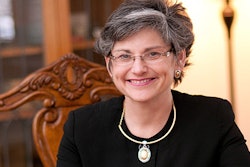Faculty are slowly becoming more racially and ethnically diverse – but not nearly as diverse as their students, a new Pew Research Center study found.
More than three-quarters of faculty are White compared to 55 percent of students, according to fall 2017 data from the National Center for Education Statistics. From 1997 to 2017, the number of minority students climbed by 17 percent while faculty diversity rose 10 percent.
 Dr. Ebony O. McGee
Dr. Ebony O. McGeeProgress for Black and Latinx faculty has been particularly sluggish, with their percentages rising only minimally over the course of a decade. Since 1997, the number of Latinx faculty jumped by 2 percent, and for Black faculty, only 1 percent.
The study also found that only 6 percent of faculty are Black compared to 14 percent of students. For Latinx faculty, the disparity is even wider. A fifth of the U.S. student population is now Latinx versus only 5 percent of professors.
This diversity gap has consequences for student learning. Research on elementary school and middle school students has found that students of color are more motivated and have loftier goals for college when their teachers look like them.
An American Economic Association study found similar results on community college campuses: Performance gaps between minority students and their peers – in terms of dropout rates and grades – fell by 20 to 50 percent when they were taught by minority professors.
Racial, ethnic and gender gaps between faculty and students span across disciplines, according to National Center for Education Statistics data. But 2017 research showed faculty diversity falls particularly low in science, technology, engineering and math (STEM) at the top 40 public universities.
Even at diverse schools, this can create a “micro-culture” for STEM students of color “where they’re feeling love from the university but not feeling any kind of love from their department,” said Dr. Ebony O. McGee, associate professor of diversity and STEM education at Vanderbilt University.
But McGee worries many faculty members of color aren’t “feeling the love” at all.
 Dr. Antonio Flores
Dr. Antonio FloresMcGee argued that faculty diversity is growing so slowly because departments aren’t looking to create systemic change when they hire. They’ll support a diversity workshop or a diversity celebration week, she said, but “they really don’t want true intellectual thought from people of color.”
She calls it “diversity lite.”
“They want a little dab of diversity,” McGee said. “Like there’s a cake and there’s a little bit of icing on the cake, but the cake is still going to be steeped in heterosexual-ness, Whiteness, maleness, able-bodiedness, Christianness, middle-to-upper-middle-classness… They’re still going to be steeped in the Eurocentric values many universities were founded upon.”
McGee added that some faculty of color burn out and leave academia. It can be tiring to be one of a few, she said, noting that hiring underrepresented faculty doesn’t help school diversity if they don’t stay.
“Recruiting is nothing compared to retention,” she said. “Why are you putting your energy on getting that Black body in that White environment if you don’t change the environment at all?”
According to Dr. Antonio Flores, president of the Hispanic Association for Colleges and Universities, a combination of factors specifically hold Hispanics back from becoming professors.
First of all, Latinx students might “not think of themselves as Ph.D. material, even though they are,” he said. Many of them, especially first-generation graduates, didn’t grow up knowing people who continued on to higher degrees. So, they don’t necessarily hold those aspirations for themselves, let alone have the funds and professional networks to pursue them.
“The reality is that there isn’t a sufficiently robust social capital infrastructure for them to have the support they need to get PhDs,” he said.
He also pointed out that a significant portion of Latinx students attend community colleges, which may lack the resources or prestige to advance them to graduate school.
Last, it’s a demographics issue, Flores said. A generation ago, Latinx students didn’t make up 20 percent of U.S. college students. Only recently, there’s been an “explosive” growth of Latinx students, both in K-12 and higher education. Some of those students will go on to get PhDs. The numbers will go up eventually, he said, but not yet.
Moving forward, Flores thinks both the government and schools are responsible for investing in future minority professors to close the gap between faculty and student diversity. He advocated for providing broad financial assistance and incentivizing underrepresented students to come back to their universities for graduate school.
He also suggested that the federal government could even consider forgiving loan debt for minority students over time if they return to minority-serving institutions to teach.
McGee recommended cluster hiring across ranks – bringing in multiple minority faculty members at different levels in their academic careers – as one step toward bridging the gap. That way, faculty of color will have not only peers but mentors who can advocate on their behalf, she said.
She suggested including diversity work, like workshops, as a factor in consideration for tenure, as well. McGee said she’s constantly asked to run diversity programs or represent minority perspectives on committees at Vanderbilt. While she appreciates it, these tasks take away from her research time, and they aren’t as valued in academic circles.
McGee also wants to see schools offer financial incentives to deans who run department-level climate studies and retain minority faculty.
All of these strategies require effort and financial resources, said Flores, but he argued that closing the diversity divide between faculty and students will pay off in the long run for higher education.
“I see so many possibilities, but all of them require some type of investment,” he said. “Your return on investment is going to be many times over what you invest – for your institutions, for your state, for your society in general.”
Sara Weissman can be reached at [email protected].



















